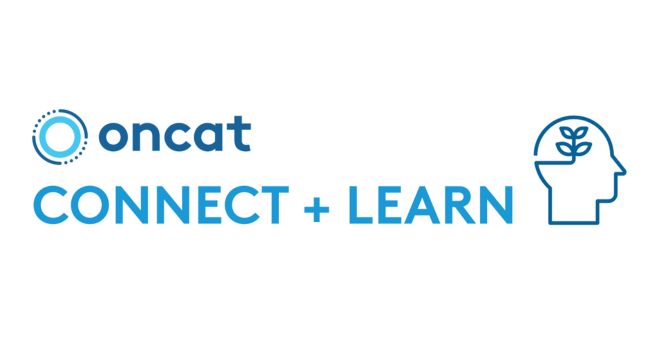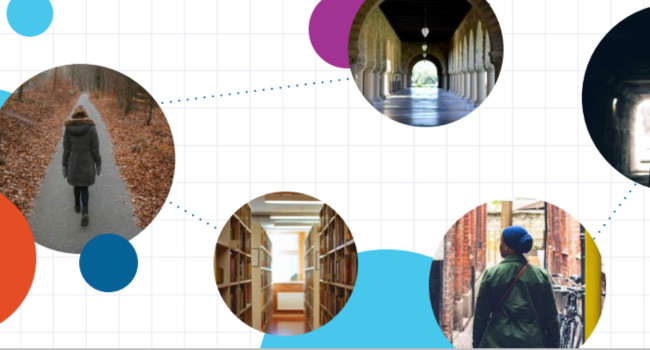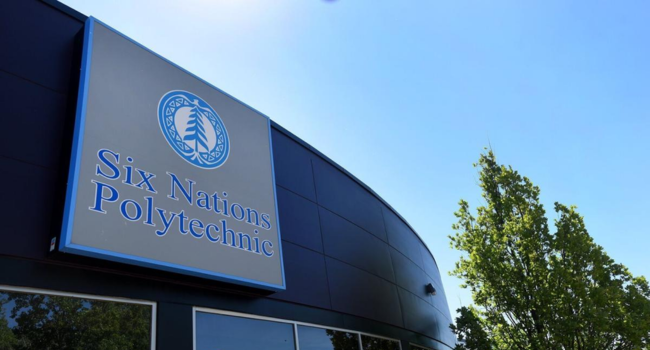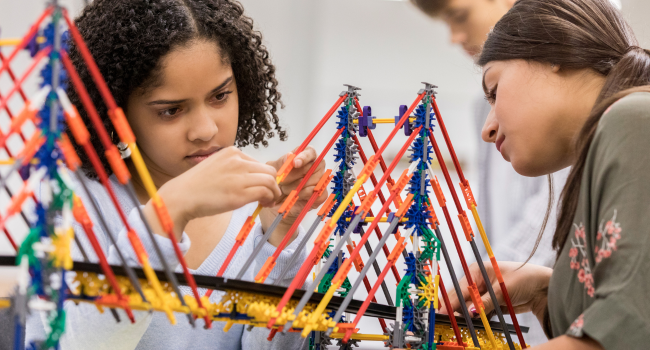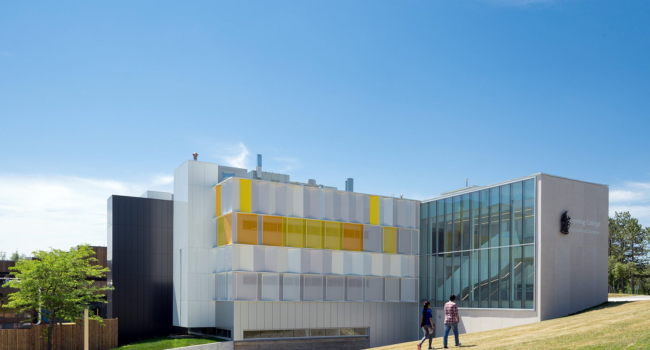Resources
Resources
Bridging Knowledge: Pathways for Indigenous Learners
Joseph Duncan, Leigh Potvin and Julie Rosenthal (Lakehead University)
What types of educational programming do Indigenous communities want postsecondary institutions to offer? And how can postsecondary institutions support Indigenous learners? Lakehead University’s School of Outdoor Recreation, Parks & Tourism sought to answer these questions through a special project that was supported by ONCAT funding.
Led by Professors Leigh Potvin and Julie Rosenthal and Indigenous Curriculum Specialist Joseph Duncan — a member of Muskrat Dam First Nation — the project team collaborated with a committee of community members from territorial and social organizations to receive guidance on the needs of their communities and how to prepare learners for careers in outdoor parks, recreation and tourism.
Cultivating land-based practices and community connections at a two-day moose hide tanning camp and developing a micro-credential in risk management are just two of the offshoots that grew from the committee's guidance. In the future, the team plans to develop more flexible degree structures for Indigenous learners through a variety of pathways with colleges and Indigenous Institutes.
What you will learn from this presentation:
- how Lakehead University’s School of Outdoor Recreation, Parks & Tourism consulted with Indigenous community members to understand their needs and desires for land-based education, credentials and support accessing the program
- what the team learned from collaborating and developing relationships with Indigenous community members and knowledge holders
- what new learners have said about their experiences in these programs
- how some of the new programming (e.g., micro-credentials) is structured
View the recording of this Connect and Learn. You can also view the presentation deck below.
Credit Check: Are We Meeting Transfer Students' Expectations?
Emerson LaCroix (ONCAT)
Despite the importance of transfer credit to learner mobility, we have little insight into how students develop their expectations about their transfer credits, or how those expectations are fulfilled once they begin their studies. In extensive one-on-one interviews, ONCAT’s Senior Researcher, Dr. Emerson LaCroix, learned from students themselves about their experiences navigating transfer in Ontario institutions. Amplifying student voices and integrating them with current research on mobility and transfer in Ontario, Emerson will unpack key findings and share implications for the sector.
What you will learn from this presentation:
- How students plan their studies with transfer credits in mind
- What supports transfer students make use of to secure transfer credits
- Common hurdles experienced by transfer students
- Student-centred considerations for improving the transfer credit process
View the recording of this Connect and Learn. You can also view the presentation slide deck below.
Changing Lives with PLAR: Fanshawe’s Pilot with Early Childhood Education and Educational Support
Christine Spicer and Kristen Young (Fanshawe College)
In 2024, Fanshawe College developed a more flexible and efficient way of recognizing prior learning, offering workers in early childhood and educational support settings the chance to receive 75% credit towards a diploma for their prior work experience. Christine Spicer, Manager of Quality Partnerships, and Kristen Young, Project Coordinator, joined us on June 18, 2025 to discuss Fanshawe’s ONCAT-funded project and the amazing work they have done to advance PLAR at Fanshawe. This new model has paved the way for learners who never imagined themselves in postsecondary before—a win-win for students and the college!
What you will learn from this presentation:
- What an efficient and flexible PLAR process can look like
- How Fanshawe uses program learning outcomes to conduct PLAR assessments
- How the team collaborated with faculty and subject matter experts
- Challenges and lessons from the project
- How ONCAT can support similar projects at your institution
Watch the recording of this Connect and Learn.
You can also download the presentation slides below.
Pathways in Chemistry and Applied Life Science
Lakehead University
This project originally stemmed from student demand. Discussion between faculty, staff, and students from Fanshawe College and Lakehead University identified potential pathway opportunities for graduates from both postsecondary institutions. After conducting a brief environmental and curriculum scan, the project team determined the need for additional resources to create a set of transfer pathways and also to assess if there were additional opportunities for pathway development.
The purpose of this project was twofold. Firstly, we aimed to develop a set of transfer pathways between the Chemical Laboratory Technology - Science Laboratory advanced diploma and the Honours Bachelor of Science (Chemistry Major)/Honours Bachelor of Science (Applied Life Sciences Major) degrees. Secondly, we wanted to assess the viability of developing additional pathways with other Honours Bachelor of Science (HBSc) programs at Lakehead University, including a double-major (Biology and Chemistry), and medical/biomedical concentrations.
Fair, Consistent, and Transparent: A Short Guide on Assessing Transfer Credits in Ontario
ONCAT
In a well-functioning transfer environment, students who transfer should not face barriers. For most postsecondary students in Ontario, however, there are significant challenges related to transfer. Transfer students may spend more time than direct-entry students completing their studies, and a significant number of these students do not graduate (Walters, Brown, Perekh, Reynolds, and Einmann, 2021). Faculty and academic departments play a vital role in this process when they assess transfer credit and make determinations about course equivalencies between two or more postsecondary institutions. And yet, despite this important role, many faculty members have shared that they do not receive guidance on how to make these decisions (Missaghian, 2021).
In response, ONCAT consulted transfer advisors, faculty members, and other key personnel to create guidelines for assessing credit. This resource provides a starting point for faculty members, department chairs, and others who wish to ensure that their decision-making process is fair, consistent, and transparent. We provide common elements to consider that can be adapted to fit the needs of a particular department or discipline. The guide includes principles of credit assessment, guidelines for making credit-assessment decisions, and other information relevant to this important process.
Indigenous Institutes and Seamless Transfer: Integrating Access and Admissions as Part of Student Mobility
Joyce Helmer, Adam Hopkins & Sarah Mignault (First Nations Technical Institute); Beverley Carter-Roy & Mark Gibeault (Kenjgewin Teg); Angela Mainville, & Brendan Smyth (Seven Generations Education Institute)
First Nations Technical Institute, Kenjgewin Teg Education Institute, and Seven Generations Education Institute agree that the prospective learner engagement and advocacy known as “Admissions” must be responsive, flexible, and dependable. There is general agreement that the Admissions teams contribute to engaging in outreach to communities and potential learners. There is a willingness to work towards a process that demonstrates “no locked doors”; and one that provides consistency across the sector and among the Indigenous Institutes across the Province.
As new accredited members in the postsecondary sector we are embarking on a path towards acknowledging history, determining where we are currently and forging completely new ways of responding to Indigenous learners in our own settings and as transfer learners.
The goal of this project was to examine the Admissions processes in three of the Province’s Indigenous Institutes to strengthen access and transfer to postsecondary education for Indigenous learners. To achieve this goal, policy and procedural changes are required. It is well known that systems change is essential to removing barriers and a conceptual shift needs to occur that is responsive and safe with policies, strategies and frameworks that are relevant, contextual, strengthens identity and ownership and promotes lifelong learning.
To that end, the First Nations Technical Institute, Kenjgewin Teg Education Institute, and Seven Generations Education Institute have worked to develop a learner-centered prospective learner engagement “Admissions” process and program that will address and remove some of the application and admission barriers that are currently encountered, provide opportunities for upgrading, upskilling, continuous professional development, and dual credit options.
The processes and program development concepts discussed in this project afforded consideration of respective community, geographical, and First Nation diversity. Attention to this detail allowed for the creation of an admissions' process that is innovative, fully transferable and adaptable for individual community and Institutions’ uniqueness.
The initial project activities required a comprehensive review of each Institute’s Admissions processes, policies and procedures. Once this baseline was established, we were able to identify challenges, gaps, and barriers that were common across the sector and create an innovative framework for a full entry year program offering.
MapIt: Reviewing Transfer Credit Processes at Ontario Postsecondary Institutions
Higher Education Strategy Associates
In 2019, the Ontario Council on Articulation and Transfer (ONCAT) commissioned HESA to undertake an exercise with ten Ontario postsecondary institutions mapping out their transfer credit processes. The objective of the MapIt 1.0 project was to help the participating institutions identify strengths in their transfer credit processes and most especially areas for improvement – while also providing ONCAT with ideas for supporting institutions. HESA completed the project in June 2020, not only providing an overall report but also facilitating workshops with all of the participating institutions. MapIt 2.0 repeated many elements of the MapIt 1.0 exercise with another nine Ontario postsecondary institutions. This report provides generalized findings from the second iteration of the project.
Indigenous Institutes Credential Recognition
Responding to barriers to educational mobility experienced by Indigenous graduates, Six Nations Polytechnic proposed to assess the recognition of its Bachelor of Arts programming and identify possible parity-catalyzing measures both internally and externally. The primary goals of the project were:
- Understanding the transfer experiences of Bachelor of Arts degree in Ogwehoweh Languages (BAOL) students by exploring and analyzing the specific hurdles to mobility they face;
- Documenting the lapses and lacunae in existing credit transfer pathways out of the BAOL program;
- Enhanced understanding of the Indigenous Institutes' sector among Ontario universities and colleges, necessary to facilitate recognition of the credentials these postsecondary bodies are empowered to grant; and
- Identification of possible internal supports and external tools that could reduce disparities in the current credit transfer system (including possible changes to BAOL curriculum)
A Toolkit to Support the Creation of Pathways for Indigenous Learners
Adam Hopkins, S. Brenda Small, Don McCaskill, Emily Willson, and Joyce Helmer (Confederation College of Applied Arts and Technology, First Nations Technical Institute, and Trent University)
In 2013, the Centre for Policy and Research in Indigenous Learning (CPRIL), Confederation College, Trent University, and the First Nations Technical Institute (FNTI) undertook a project to create pathways and to support mobility for Indigenous Learners across their partnering institutions. This work has grown to be a strong collaboration of Steering Committee members who represent a total of fifteen postsecondary institutions from across Ontario. Indigenous ceremony and methodologies such as relationship building, reflection, building a shared understanding, and collaboration, ground the work of the group. Overall, the Pathways for Indigenous Learners Steering Committee seeks to build responsible pathways and partnerships that support Indigenous learners throughout their postsecondary journeys, from one learning community to another. Over 2019/20, the Steering Committee undertook this new project, Mobilizing Knowledge, which aimed to implement and share key findings that have been generated from five years of experience with creating pathways for Indigenous learners. Specifically, this project relied on key findings to develop new and existing pathways, produce resources such as a Pathways Tool Kit, and disseminate knowledge to external groups. Overall, the group was successful in enhancing and finalizing pathways, bringing the total number of pathways to fifteen, in creating a toolkit to facilitate institutions in undertaking their own work on creating and supporting pathways, and in meeting with external groups and individuals from across the province and country.
Visualizing the Mapping of Outcomes, Content, and Curriculum Between Programs to Support Transfer
Nerissa Mulligan, Jake Kaupp, Vijay Mago, Sahib Singh Budhiraja, Brian Frank, Roderick Turner, Mary Pierce
This project was developed from two previous projects funded by the Ontario Council on Articulation and Transfer (ONCAT). The first project was conducted in 2015 (Zakani et al., 2016), and involved the creation of a framework to compare engineering technology diploma programs and engineering degree programs in Ontario. This was primarily accomplished by comparing selected courses and skills that were found to be part of most engineering programs, such as Calculus and Physics. In 2016, the second project (Waller et al, 2017) focused on engineering discipline-specific program comparisons using parts of the Zakani et al. (2016) framework to compare electrical engineering to electrical engineering technology and mechanical engineering to mechanical engineering technology. Information visualizations of large data sets of information was a key technique used in the analysis in both the Zakani et al. (2016) and Waller et al. (2017) studies. The idea for the current research project came from the extensive use of visualizations in the two previous ONCAT-funded projects. One of the primary goals of the current project is to enable those working with transfers to produce similar visualizations to help support student transfer and mobility in Ontario and possibly lead to bridging programs or pathways between programs and institutions. Information visualizations can be a useful way to display data, particularly data that may otherwise only be available in text-form. They can also help identify trends, similarities, connections, and gaps between courses or programs.
A Framework for Data Sharing in Academic Collaborations and Pathways
Data Sharing in Academic Collaborations and Pathways was a qualitative research project which examined this practice in six Ontario postsecondary institutions. A larger more detailed report has been produced about the transfer of data among academic institutions in Ontario. However, below is a synopsis and excerpts of highlights from the larger report. As the lead institution on the project, York University followed institutional guidelines for the tendering of the research through its Procurement Services office. Thinklounge was the successful bidder and was subsequently hired to conduct the study by the project team.
Pathway for Admission: University Academic Preparation and Retention at a Community College
Glenn Harvel, Jennifer Percival, Joe Stokes, Alena Shah & Jeff Zakoor (University of Ontario Institute of Technology and Durham College)
The pathway allows successful students who would otherwise not be admissible to university, to be eligible to enter a Bachelor’s degree with advanced standing. The pathway is intended to be delivered during the summer before University starts but after their high school grades are known. The courses will concentrate on academic success, communication, and math skills necessary to be successful in first year University. The program also offers the option to transfer instead to the college and enter a General Arts and Science certificate program.
Shifting the Landscape: A Framework for Creating Pathways in Indigenous Education
This document emerged from the partnership of three postsecondary institutions: a college (Confederation), a university (Trent), and an Indigenous Institute (First Nations Technical Institute). Each of these three schools has been recognized for its leadership in postsecondary Indigenous education. Drawing from this collective experience, representatives of the partner institutions came together to engage in research that could inform the present and future of Indigenous education. They formed a project team (“the Team”) that would guide and direct the Framework Project.
The Team developed a questionnaire which would form the basis of focus groups and key informant interviews. They consulted with a broad mix of respondents from participant institutions and organizations, pursuing structured conversation to answer the following questions:
- What are the needs of learners in Indigenous studies?
- What is the place or position of Indigenous studies programming in Ontario's postsecondary learning environments?
- Does such programming, where it exists, meet learner needs?
- Are there pathways across Indigenous Studies programs that are meeting identified needs?
- How, if those needs are not being met, can institutions create new and better pathways?
Fleming College & Trent University University Transfer Expansion
Joe Muldoon (Trent University, Project Lead) Hailey Wright (Trent University, Co-Lead Coordinator), David Adam Baker (Fleming College, Co-Lead Coordinator)
In June 2015, Trent University and Fleming College began discussions regarding the existing General Arts & Science – University Transfer stream and the potential opportunity to expand it into the science and business disciplines. The goal of the pathway is to facilitate second-year entry into strategic Bachelor of Science majors and the Bachelor of Business Administration programs, in addition to the existing Bachelor of Arts second-year entry and limited transferability into the Bachelor of Science degrees. Moreover, both agreed to expand the pathway entry points from traditional Fleming recruitment and admission processes and Trent’s redirect upon application processes to include a Trent redirect of students facing suspension from the University. The project secured funding in October 2015. From November 2015 to August 2016 new courses were developed by Fleming and courses granted equivalency by Trent. Courses developed include: Preparatory Calculus, Calculus I (60 hrs.), Calculus II (60 hrs.), Biology I (60 hrs.), Biology II (60 hrs.), and Introduction to Management. All developed courses have received full equivalency approvals. Trent and Fleming are committed to a successful program launch and both institutions will continue to support student success through enhanced pathway opportunities.
University to College Pathway for Students Not Meeting Academic Progression Requirements in Administrative Studies
Henry Decock, Karen Murkar, Kim Michasiw, Julie Parna (York University)
Building on their long standing relationship, York University and Seneca College developed a redirect pathway for struggling administrative studies degree students. Administrative studies students who have been required to withdraw from York University will be given the opportunity to complete an Accounting Diploma at Seneca College, where upon successful graduation they will be able to transition back into York University through the summer bridge program to finish the degree in which they began. The project is premised upon university students desire to complete a credential in the field but whose learning needs and style may be better suited in the college environment. For both York and Seneca, the project represents a collective effort to increase student retention in post-secondary education and whose processes serve as a model for other high affinity programs between regional institutions.
Success of this initiative will be dependent on the quality of advising. Identified personnel at York University will meet with students at the end of the first year to discuss this option. Students wanting to avail themselves of the possibility will be directed to a specific academic advisor in the Accounting program at Seneca College who will be able to map out a plan for completion. An admissions person specializing in articulation agreements will process the intake and generate an immediate acceptance. Redirection into Seneca and transition back to York will be completed internally between institutions and the students will not be required to navigate through the respective central application services.
It is expected the redirected students will receive some transfer credit at Seneca for their completed courses, thereby allowing for an individualized course schedule to expedite a return to York University. With multiple intakes each year, the Accounting program is particularly suited for this initiative and students will be able to enroll in any course they require, even ones which would reduce the existing bridge requirement necessary to re-enter York at year three of their original degree program.
Based on the number of students who meet the minimum criteria of successfully completing 6.0 credits at York University in the Administrative studies program, it is expected there will sufficient numbers to make the project viable. Representatives from Seneca and York will meet annually to review and adjust where necessary to ensure the seamlessness of the student movement. The parties have committed to internal communications to help make the program attractive, including informing all Accounting students of the Bridge program developed by York University for an earlier ONCAT funded project. This initiative will also be part of an anticipated multi-institutional research project on redirection tracking and mechanisms in the province of Ontario.
Transitioning to University: Best Practices for College Transfer Bridging Courses
Dr. Nancy Luckai, Rachel Kushnier, Calla Sampson, Sarah Prouty, Anna Meer, Anthea Kyle, Andrea Tarsitano, and Andrew Heppner (Lakehead University)
The intent of this project was to develop a series of best practices and guidelines to inform the creation of bridging curricula and tailored supports that enhance the success of college to university transfer students while supporting all types of institutional transitions in the context of Ontario’s postsecondary education system. A previous ONCAT funded project (Lakehead, 2012) identified that college transfer students entering Lakehead University through block transfer pathways had the highest retention rates and Grade Point Averages in comparison to transfer students entering with advanced standing or other types of postsecondary credit. The study recommended follow up work into the characteristics and experiences of college transfer students to better understand differences in success and retention rates. As a result of this project, we found that Lakehead University has a rich and varied context of transfer students in which to examine bridging processes including:
- College to University Block transfer with summer transition programming and curriculum (e.g. Engineering, Natural Resource Management)
- College to University Block transfer directly into various year levels (e.g. Applied Life Sciences, Business, Social Work)
- Advanced Standing students across programs with credit transfer assessed on an individual basis
- Varied and unexpected transfer students whose educational context includes:
- Partially completing some university before transfer to Lakehead
- Partially completing some college and some university before transfer to Lakehead
- Partially completing a college diploma then completing a full university degree before transferring credit to Lakehead University.
Pathways for Aboriginal Learners: Phase 1
The Centre for Policy in Aboriginal Learning, Confederation College
This report provides a summary of the activities undertaken in the initial year of the “Pathways for Aboriginal Learners: Collaborating across Aboriginal Institutes, Colleges and Universities” project as well as next steps. Key deliverables, financial expenditures and pathway development are reported on. Commencing in August 2014, “Pathways for Aboriginal Learners: Collaborating across Aboriginal Institutes, Colleges and Universities” is a two-year project funded by the Ontario Council of Articulation and Transfer (ONCAT). Through a tripartite partnership between The Centre for Policy in Aboriginal Learning (CPAL), Confederation College (main proponent), First Nations Technical Institute (FNTI) and Trent University (Trent), the project seeks to create distinct academic and student support pathways that are rooted in Indigenous knowledges, for Aboriginal Learners, making it the first Indigenous-centered transition Pathways model for Aboriginal transfer students in Ontario. To date knowledge exchange and the creation of a memorandum of understanding between the three institutions has occurred. A review and evaluation of curriculum alignment, and the creation of a draft articulation agreement are also complete. Alongside these efforts, work to support learner’s transitions have begun, through a process of asset mapping and support and recruitment focused discussions with Aboriginal learners. An analysis of the content of Indigenous Studies, Environmental and Social Work programs at Trent, Confederation, and FNTI confirmed the feasibility of creating distinct pathways in Indigenous Studies, with the need for additional exploratory work in the areas of Environmental Studies and Social Work. A first cohort of transfer students (a soft launch) from the Confederation College Aboriginal Community Advocacy program to the Trent University Indigenous Studies program will take place in September 2015, which will see students entering the third year of study. A corollary of the exercise of mapping transferability within Indigenous programs, and between Indigenous and non-Indigenous programs is the identified need for a culturallyinformed strategy of alignment. Preliminary efforts to align curriculum utilizing Confederation College’s “Aboriginal Learning Outcomes” as a companion framework to the Learning Outcomes approach is underway.
No Results
Learn about how you can partner with us. Help us improve our project search, provide your feedback.

